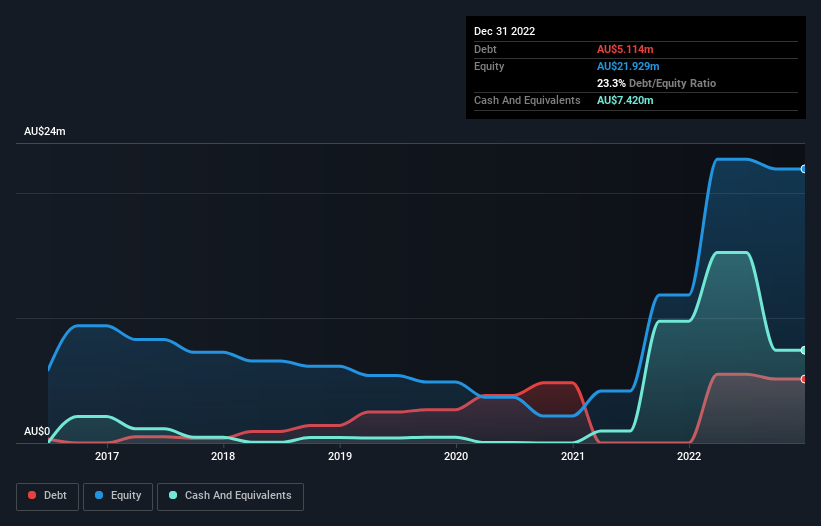Some say volatility, rather than debt, is the best way to think about risk as an investor, but Warren Buffett famously said that 'Volatility is far from synonymous with risk.' When we think about how risky a company is, we always like to look at its use of debt, since debt overload can lead to ruin. As with many other companies Latrobe Magnesium Limited (ASX:LMG) makes use of debt. But the more important question is: how much risk is that debt creating?
What Risk Does Debt Bring?
Debt is a tool to help businesses grow, but if a business is incapable of paying off its lenders, then it exists at their mercy. In the worst case scenario, a company can go bankrupt if it cannot pay its creditors. However, a more frequent (but still costly) occurrence is where a company must issue shares at bargain-basement prices, permanently diluting shareholders, just to shore up its balance sheet. Of course, the upside of debt is that it often represents cheap capital, especially when it replaces dilution in a company with the ability to reinvest at high rates of return. The first step when considering a company's debt levels is to consider its cash and debt together.
View our latest analysis for Latrobe Magnesium
What Is Latrobe Magnesium's Net Debt?
You can click the graphic below for the historical numbers, but it shows that as of December 2022 Latrobe Magnesium had AU$5.11m of debt, an increase on none, over one year. But on the other hand it also has AU$7.42m in cash, leading to a AU$2.31m net cash position.

A Look At Latrobe Magnesium's Liabilities
The latest balance sheet data shows that Latrobe Magnesium had liabilities of AU$1.94m due within a year, and liabilities of AU$13.5m falling due after that. On the other hand, it had cash of AU$7.42m and AU$3.87m worth of receivables due within a year. So its liabilities total AU$4.11m more than the combination of its cash and short-term receivables.
Given Latrobe Magnesium has a market capitalization of AU$115.3m, it's hard to believe these liabilities pose much threat. Having said that, it's clear that we should continue to monitor its balance sheet, lest it change for the worse. While it does have liabilities worth noting, Latrobe Magnesium also has more cash than debt, so we're pretty confident it can manage its debt safely. The balance sheet is clearly the area to focus on when you are analysing debt. But it is Latrobe Magnesium's earnings that will influence how the balance sheet holds up in the future. So if you're keen to discover more about its earnings, it might be worth checking out this graph of its long term earnings trend.
Since Latrobe Magnesium has no significant operating revenue, shareholders probably hope it will develop a valuable new mine before too long.
So How Risky Is Latrobe Magnesium?
Statistically speaking companies that lose money are riskier than those that make money. And the fact is that over the last twelve months Latrobe Magnesium lost money at the earnings before interest and tax (EBIT) line. Indeed, in that time it burnt through AU$11m of cash and made a loss of AU$3.1m. With only AU$2.31m on the balance sheet, it would appear that its going to need to raise capital again soon. Overall, we'd say the stock is a bit risky, and we're usually very cautious until we see positive free cash flow. When analysing debt levels, the balance sheet is the obvious place to start. But ultimately, every company can contain risks that exist outside of the balance sheet. We've identified 4 warning signs with Latrobe Magnesium (at least 3 which are potentially serious) , and understanding them should be part of your investment process.
If you're interested in investing in businesses that can grow profits without the burden of debt, then check out this free list of growing businesses that have net cash on the balance sheet.
New: AI Stock Screener & Alerts
Our new AI Stock Screener scans the market every day to uncover opportunities.
• Dividend Powerhouses (3%+ Yield)
• Undervalued Small Caps with Insider Buying
• High growth Tech and AI Companies
Or build your own from over 50 metrics.
Have feedback on this article? Concerned about the content? Get in touch with us directly. Alternatively, email editorial-team (at) simplywallst.com.
This article by Simply Wall St is general in nature. We provide commentary based on historical data and analyst forecasts only using an unbiased methodology and our articles are not intended to be financial advice. It does not constitute a recommendation to buy or sell any stock, and does not take account of your objectives, or your financial situation. We aim to bring you long-term focused analysis driven by fundamental data. Note that our analysis may not factor in the latest price-sensitive company announcements or qualitative material. Simply Wall St has no position in any stocks mentioned.
About ASX:LMG
Latrobe Magnesium
Engages in the construction and commissioning of a production plant for the extraction of magnesium metal and by-products from magnesium rich waste feedstocks.
Moderate risk and good value.
Market Insights
Community Narratives



